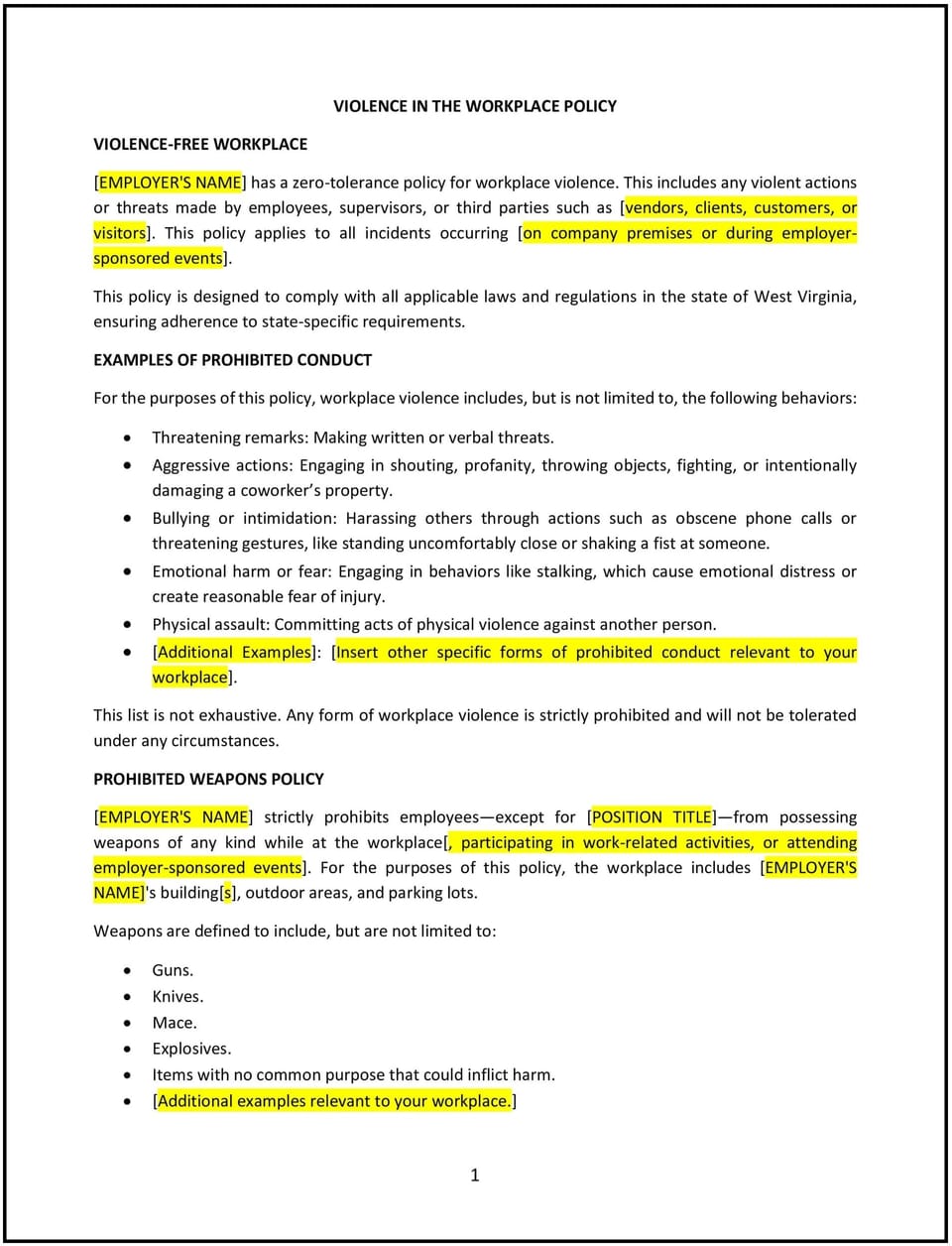Violence in the workplace policy (West Virginia): Free template

Violence in the workplace policy (West Virginia)
In West Virginia, a violence in the workplace policy establishes guidelines to promote a safe and secure work environment, free from threats, intimidation, or acts of violence. This policy ensures that all employees understand their rights and responsibilities in preventing workplace violence while outlining clear procedures for handling incidents.
The policy defines prohibited behaviors, reporting procedures, and preventive measures to foster a respectful and secure workplace.
How to use this violence in the workplace policy (West Virginia)
- Define prohibited behaviors: Specify actions that constitute workplace violence, including physical aggression, verbal threats, harassment, or intimidation.
- Establish reporting procedures: Provide clear steps for employees to report incidents of violence, including contact information for HR or security personnel.
- Outline investigation protocols: Detail the process for investigating reports of workplace violence, ensuring fairness and confidentiality.
- Include preventive measures: Highlight steps to prevent workplace violence, such as employee training, safety assessments, and conflict resolution resources.
- Support compliance: Ensure the policy aligns with West Virginia labor laws and federal regulations to protect employee safety and rights.
Benefits of using a violence in the workplace policy (West Virginia)
- Enhances safety: Reduces the risk of violence and promotes a secure environment for employees, customers, and visitors.
- Supports compliance: Aligns with West Virginia laws and federal workplace safety regulations, such as OSHA requirements.
- Encourages reporting: Provides employees with clear and confidential channels for reporting concerns or incidents.
- Protects morale: Fosters a respectful and supportive workplace culture, reducing stress and improving employee satisfaction.
- Minimizes risks: Reduces the organization’s liability and reputational risks by addressing workplace violence proactively.
Tips for using a violence in the workplace policy (West Virginia)
- Communicate the policy: Share the policy with employees during onboarding and regularly reinforce its importance through training and communications.
- Train supervisors: Provide training to managers on recognizing warning signs of violence, handling complaints, and implementing preventive measures.
- Foster a culture of respect: Promote open communication and mutual respect to reduce conflicts and tensions in the workplace.
- Maintain documentation: Keep detailed records of reported incidents, investigations, and outcomes to ensure accountability and compliance.
- Review periodically: Update the policy to reflect changes in West Virginia laws, workplace practices, or organizational needs.
Q: What behaviors are considered workplace violence under this policy?
A: Workplace violence includes physical aggression, verbal threats, harassment, intimidation, and any behavior that creates a hostile or unsafe environment.
Q: How should employees report incidents of workplace violence?
A: Employees can report incidents to HR, their supervisor, or designated security personnel, following the procedures outlined in the policy.
Q: What steps does the organization take to prevent workplace violence?
A: Preventive measures include employee training, regular safety assessments, and resources for conflict resolution and stress management.
Q: How does this policy comply with West Virginia laws?
A: The policy aligns with West Virginia labor laws and federal workplace safety regulations, such as OSHA requirements, to ensure a secure work environment.
Q: What happens after a report of workplace violence is made?
A: The organization will investigate the report promptly, maintaining confidentiality and taking appropriate corrective actions based on the findings.
This article contains general legal information and does not contain legal advice. Cobrief is not a law firm or a substitute for an attorney or law firm. The law is complex and changes often. For legal advice, please ask a lawyer.


